Whether you’ve just started jogging or you’re a veteran of pounding the pavements (or treadmill), pain after running is a common complaint. It might start as a niggling twinge, but could become a permanent part of your run if left untreated. It could even cause further problems elsewhere that leave you unable to train, so don’t just ignore what might currently be an annoying discomfort. Getting a massage for pain caused by running is the best way to stop it becoming more serious.
Table Of Contents
- What Causes Pain After Running
- Knee Pain After Running
- Massage For Knee Pain After Running
- Shin Pain After Running
- Massage For Shin Pain After Running
- Hamstring Pain After Running
- Massage For Hamstring Pain After Running
- Lower Back Pain After Running
- Massage For Lower Back Pain After Running
- Shoulder Pain After Running
- Massage For Shoulder Pain After Running
- Summary
- Book A Mobile Massage
What Causes Pain After Running
There is a reason that running is such good exercise – it’s hard work. And it’s hard work because it involves all the major muscle groups in your lower and upper body. This includes stabilisation and shock impact by your core, while your arms, shoulders and back help maintain balance and momentum(1). The precise use of muscles depends on your running action and whether you prefer sprints, long distance or something in between. But however you run, if you push yourself things can get uncomfortable by the time you reach the finish line. However, that’s not the same as your shins hurting every time your foot hits the ground or waking up the next day with lower back pain.
If left untreated, pain can cause you to alter your running action so the affected muscle doesn’t have to work as hard. For example, knee pain can cause you to rotate your hip internally or externally from where it should be. And this just adds a new issue which is likely to cause you problems in the future. In this case, shin, hip or even lower back pain.
So let’s take a look at some common problem areas and what might be causing them.
Knee Pain After Running
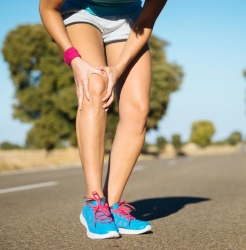
Many people automatically assume that knee pain after running is a sign of cartilage damage. And while this is a possibility, it could also be related to ligament or muscles issues. Hundreds or thousands of steps per run, especially on concrete or tarmac, takes its toll on shock-absorbing cartilage. And once the damage has occured, treatment options arae limited.
Ligaments, of which there are 4 main ones, hold the bones of the upper and lower leg in place. They can become damaged by over extension, such as a sudden turn, though this is unlikely if you’re just out for a run. Instead it is muscle issues, even without injury, that are the cause of most knee pain after running. The hamstrings at the back of your thigh and the quadriceps at the front can become tight and inflamed. And because they pass over your knee this can lead to pain above, below or along either side of it.
Massage For Knee Pain After Running
To rule out potential cartilage or ligament damage, initial examination of knee issues by your doctor is crucial. This is especially important if it is severe, came on suddenly or there is any swelling. After ruling out anything serious, issues through an initial medical examination, a targeted massage can treat knee pain caused by running. It can also reduce inflammation and help to relax tight muscles in your legs to treat or even prevent knee pain.
Shin Pain After Running
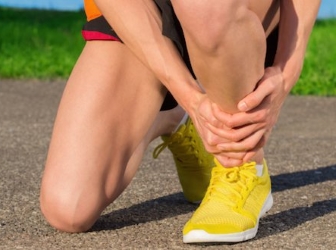
Shin pain, usually known as shin splints, refers to pain below the knee and above the ankle. But another possibility is a stress fracture. Shin splints cause pain that radiates down the majority of the lower leg and tends to feel worse the day after exercise. A stress fracture is only painful at the site of the injury and feels slightly better after a day’s rest.
The most common cause of shin splints is weak muscles at the front of the lower leg and stronger, often tighter muscles at the back. Beginners can develop the problem from trying to progress too quickly, but a seasoned veteran can also suffer. This is especially likely if a build up of injuries or muscle imbalances has lead to an improper running action(2).
Massage For Shin Pain After Running
If running gives you painful shins you should reduce your training to a level that doesn’t aggravate it. This might mean that you have to take a break from training for a few weeks. Also, given that muscle tension and imbalances are likely to have at least contributed to your shin pain, massage to the lower leg will help correct this. This includes the calves at the back and tibialis anterior at the front. Your upper thigh muscles may also benefit from massage if the issue has progressed to other areas. Click for more information on shin splints
Hamstring Pain After Running
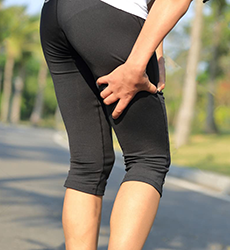
Hamstrings are the muscles at the back of your upper thigh, extending from your pelvis down to your lower leg. Bending your knee and powering explosive movements like deadlifts and squats rely heavily on the hamstrings. Long periods of sitting, whether it’s at a desk or watching TV, causes them to shorten and become tight. And they can also become inflamed by running, especially if it involves inclines. The result is pain after running that isn’t just due to sore muscles but to areas of tension (knots). These can in turn progress to strains and tears if left untreated.
Hamstring pain can also affect your running action. Shortening your stride in an attempt to stop you aggravating the problem area. It can also pull your hips out of alignment which can lead to lower back pain.
Massage For Hamstring Pain After Running
Painful hamstrings after running, whether caused by tension, knots or inflammation, can benefit from massage. Having a deep-tissue sports massage will relax and lengthen your muscles to increase flexibility. Hamstrings can also benefit from a sports massage after running as it helps to prevent soreness the next day. This can also help your pelvis to return to its correct alignment and ease lower back problems.
Lower Back Pain After Running
As mentioned above, tight hamstrings can be the source of lower back pain. But there are other possible causes.
Gluteus Medius
One potential cause is a tight or strained gluteus medius muscle, which is deep under your gluteus maximus. Together these are better known as your buttock. The job of the gluteus medius is to abduct your hip, to move it outwards away from your other leg. Plus it stabilises your pelvis and keeps it level when one foot is off the ground, such as when running. Sitting for long periods can cause a lack of flexibility in the glutes, which can radiate into the hip. And putting in the miles, especially on hard surfaces, can lead to painful glutes.
Tight or painful glutes can then lead to weak glutes from lack of proper use. And this means muscles in the lower back have to take over the job of hip adduction when walking or running. This is why some people have to swing their leg out and forward to run rather than just straight forward. Overworked lower back muscles, forced to compensate for weak glutes, cause inflammation and pain
IT Band
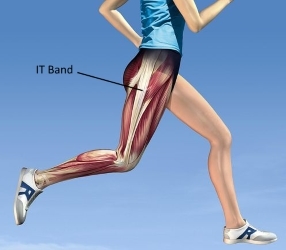
The IT Band is a thick band of connective tissue and fascia that runs from your hip to the outside of your knee. It works with muscles to extend your hip and, like the gluteus medius, with abduction. Plus it helps to rotate your leg and stabilise your knee. Running can cause your IT Band to become inflamed, especially if you have poor technique. Which in turn can lead to hip or knee pain after running. And because it connects to your hip it can also affect your gluteus medius muscle, which as stated above, can cause lower back pain.
Lower Back Issues
Although lower back pain often has its source elsewhere, that doesn’t mean the problem can’t simply be with the muscles of your lower back. And it can also be the case that your lower back is causing problems in other areas. An example is a misaligned pelvis putting more stress on one leg, and one knee, than the other. This can be caused by prolonged sitting or standing with poor posture, muscle imbalances or injury. Injuries, such as strains, tears or even a slipped disc, usually occur with heavy or awkward lifting. But sometimes a sneeze or just bending down to tie your shoelace can be enough to cause a significant injury. Especially if there is already an underlying issue.
Massage For Lower Back Pain After Running
If you get lower back pain after running, massage to the affected muscles will help to reduce areas of tension and inflammation. Along with any scar tissue that might have built up due to injury. As mentioned above though, your lower back issues may well be a symptom of muscles problems elsewhere. Therefore you would also benefit from massage to the areas that are the source of your lower back pain.
Shoulder Pain After Running
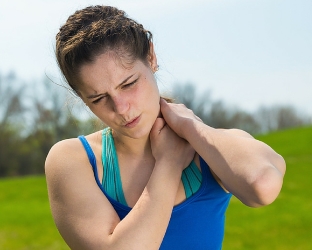
Shoulders generally aren’t the first place people think they might feel pain after running. After all, it’s your legs that do all the work and take most of the impact. But if running makes your shoulders sore or you wake up the next day and they feel tight, you know this isn’t the case.
Your arms swing as part of your running action and it is your shoulders that are making this happen. If you have tight muscles, whether from stress or tension, you might be shrugging your shoulders as you run. This can cause pain and inflammation which makes the situation worse the next time you train. This would be felt mostly in your neck and the top of your shoulders.
If the pain is closer to your shoulder joint or upper back the problem is more likely to be with your rotator cuff. An indication of this is if reaching overhead causes discomfort, or if the pain is worse lying on your side(3).
Massage For Shoulder Pain After Running
Stress or poor posture can manifest as tension in your trapezius, leading to shoulder pain after running. This muscle extends from the centre of the back up to your shoulders and neck. By applying deep tissue massage to the trapezius, you can ease its tension, promoting a more relaxed running action and improving shoulder mobility.
If the issue is more to do with your rotator cuff, massage can help to reduce tension and inflammation in the affected area. It can also increase flexibility and allow the muscles to regain strength and functionality. Click for more information on shoulder pain.
Summary
These are some of the most common areas you could feel pain after running along with the most common causes. But running is tough on your body and affects many other muscles. So while discomfort might just mean you’re pushing yourself, pain is your body’s way of telling you something isn’t right. Don’t ignore it if you want to stay healthy, see a massage therapist.
Book A Mobile Massage
If you would like to book a massage for pain after running please contact me on 07713 250352 or email david@massageinyork.co.uk. Includes sports massage, deep tissue massage and Swedish massage. For more information on booking click here
